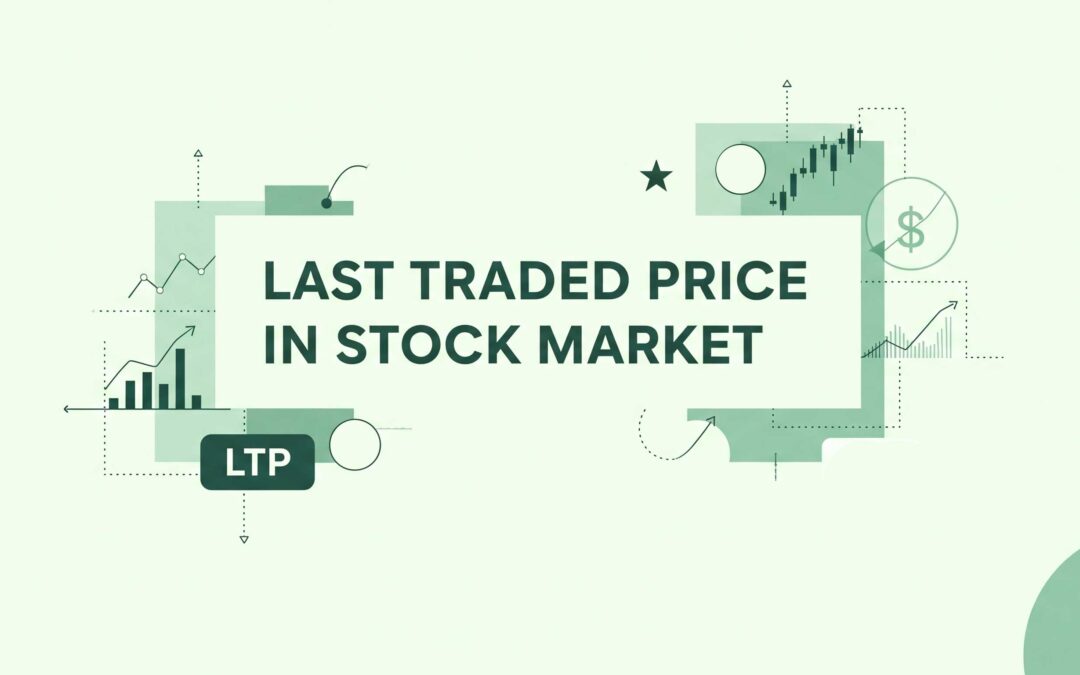Investors know the importance of time. Delaying the decision by even a minute can cause a huge loss to the traders, especially those trading in the short term. Last Trade Price (LTP) reflects the price at which a particular stock was last traded. It helps in determining the value of future stocks, and traders may use it to perfectly time the market.
But are individuals beginning their trading journey familiar with these concepts? The answer may be a “no”. This article will help you understand the basics of LTP and the procedure by which you can calculate it.
What is LTP?
The most recent price at which a security (such as a stock, bond, or derivative) was purchased or sold on a stock exchange is known as the LTP (Last Traded Price). It provides traders and investors with a real-time view of the market’s valuation of that specific asset and reflects the most recent transaction.
LTP only displays the price of the most recent completed trade and not the average price. During market hours, it fluctuates a lot, particularly for stocks that are actively traded.
Key Features:
- Every successful trade causes it to update in real time.
- The “ask price” (selling price) and the “bid price” (buying price) are not synonymous with LTP.
- Analysts and traders use it as a benchmark price when making decisions.
- If the most recent trades were at different prices, LTP may differ between exchanges (for example, NSE vs. BSE).
For instance, the LTP of Tata Steel would be 143 if the buyer and seller decided to exchange at that price.
Why LTP Matters to Investors and Traders?
1. Real-time Market Sentiment Reflection
LTP instantly conveys the current market’s assessment of a stock’s value as it shows real-time data.
- A rising LTP indicates strong buying interest, which may be good news for investors.
- A declining LTP indicates negative sentiment towards the stock by the investor or selling pressure.
- Investors can detect intraday trends with the help of high-frequency updates.
2. Essential for Entry and Exit Decision:
Traders rely on LTP to precisely time their trades, particularly swing and intraday traders.
- It serves as a catalyst for the issuance of buy and sell orders.
- Aids in determining precise take-profit or stop-loss levels.
- Breakouts are confirmed when the LTP moves decisively beyond a well-defined support or resistance level, typically accompanied by increased trading volume.
- LTP is used by traders in conjunction with indicators such as VWAP, MACD, and RSI.
3. Assists Long-Term Investors in Tracking Portfolio Value
LTP is important when tracking investments, even though long-term investors are less sensitive to minute-by-minute fluctuations.
- Gives current individual holdings’ valuations.
- Helpful for scheduling decisions about rebalancing or booking profits.
- Aids in determining whether a stock is performing better or worse than the market.
- Helps compare prices to those of prior purchases.
How Is LTP Calculated?
You might be thinking there is some mathematical formula to calculate LTP, which is not the case. Let’s look at how it is calculated to help you gain clarity:
1. Matching of Trade Price:
- Every time a buy order and a sell order match and an exchange transaction is finished, LTP is updated.
- The bid price is the highest amount the buyer is willing to pay.
- The seller provides the lowest amount (ask price) that they are prepared to take.
- The trade is executed at the coinciding price, which becomes the LTP.
2. Absence of a mathematical formula
LTP is transaction-based rather than computation-based, in contrast to averages. It is selected straight from the most recent trade that was completed, so there’s no need to compute it.
For instance:
- At Rs 1,200, Buyer A wants to purchase 90 shares of Reliance.
- At Rs 1,200, Seller B is prepared to sell 90 shares.
- The LTP changes to ₹1,200 after this trade is completed.
3. Modifies Continually Throughout Market Hours
Particularly in liquid stocks or indices, LTP can fluctuate several times per second.
- The LTP may update 1,000 times in a minute if 1,000 trades occur.
- Regardless of volume, it always shows the most recent matched trade.
4. Unique Price:
Although LTP is sometimes confused with other price indicators like open price, close price, etc., it is not the same:
Take a look at the table to understand different terms associated with price:
| Price Type | Description | Calculation Method |
| Open Price | First trade price of the day | First transaction of the day |
| Close Price | Last trade price at market close | Last transaction market closing |
| High/Low Price | Highest/Lowest price of the day | Based on the price range of all trades |
| LTP | Price of last trade | Not calculated mathematically |
Bottomline
The conclusion can be drawn that the Last Trade Price is not derived from any mathematical formula, nor is it any other price, like open, close, etc. It simply shows the price at which the most recent trade took place of a particular stock. The trade takes happens when the price and quantity match from both the buyer and seller side.
It is essential for traders to know these terms that will help them in an efficient and smooth trading experience. Lacking such knowledge may affect the quality of trade and the profit generated.


